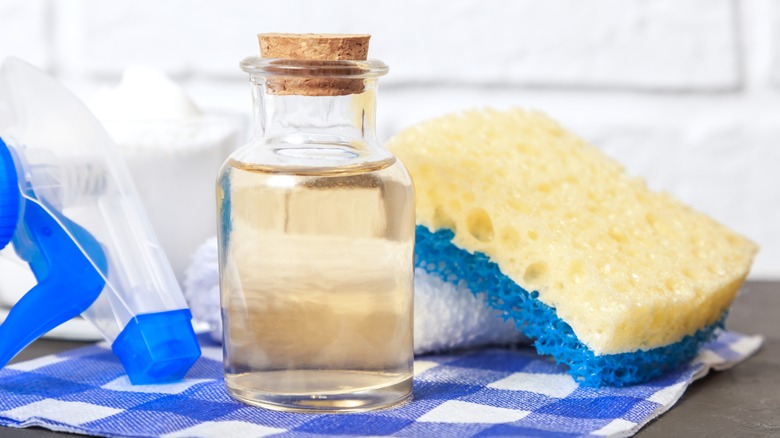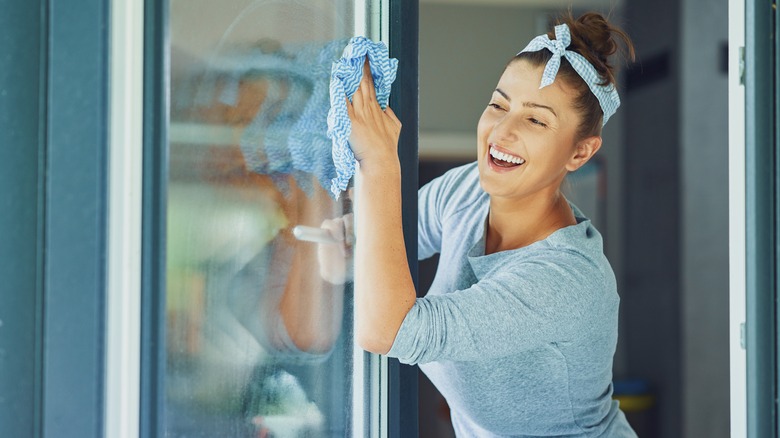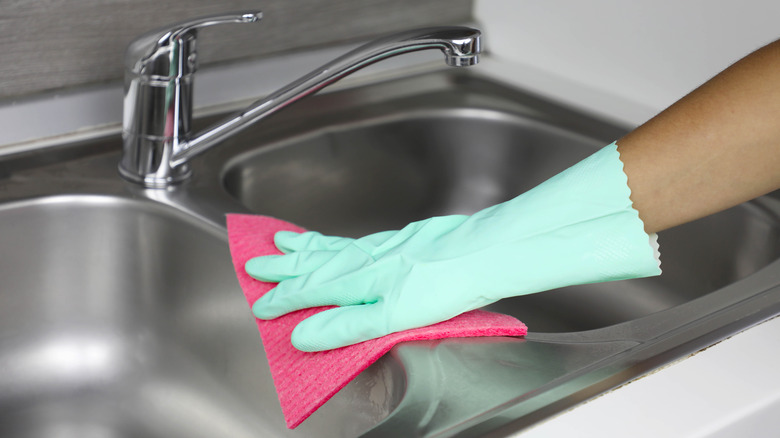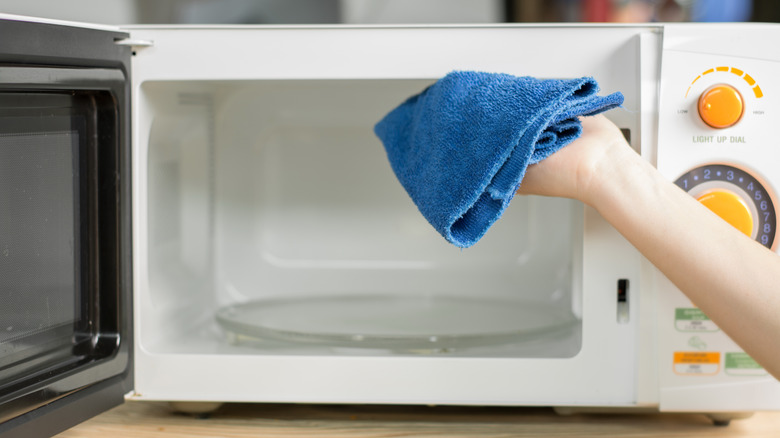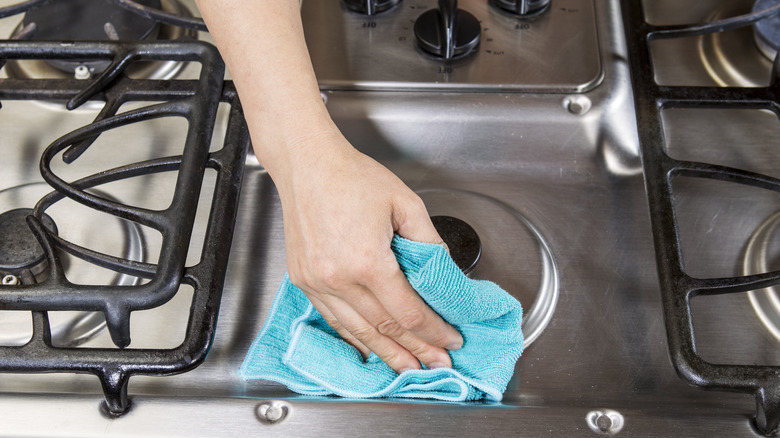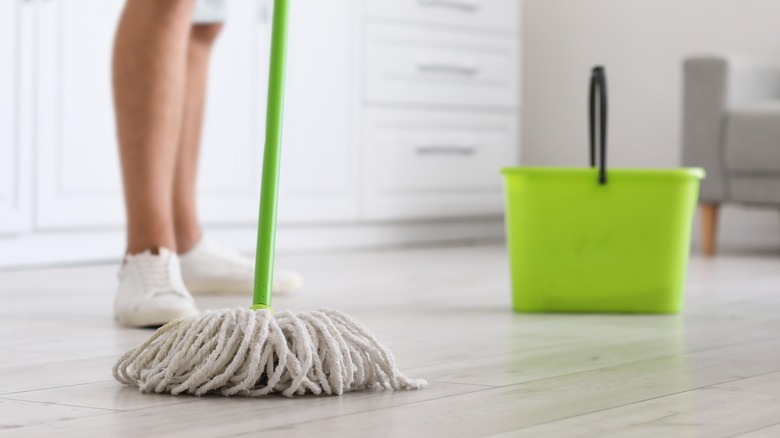How To Clean Your Kitchen With Just Apple Cider Vinegar
White vinegar has long been used as a natural alternative to conventional chemical-based house cleaners. It's nontoxic, eco-friendly, pet-safe, and inexpensive, making it easy and cheap to use as a multitasker for keeping your kitchen clean. White vinegar is also highly acidic, which is what makes it such a powerful dirt remover, but it can also be too strong for some surfaces. That's where apple cider vinegar (ACV) comes to the rescue.
Made from fermented apples, ACV can be used in all the same cleaning applications as white vinegar, but is less acidic and therefore not as harsh. Its smell is less strong, too, and any lingering scent fades away quickly. A study published in the International Journal of Microbiology shows that apple cider vinegar possesses antibacterial qualities and can reduce or kill germs that cause certain foodborne illnesses. It is not, however, considered to be an effective disinfectant. Where it is most efficient is for cleaning purposes in low-risk areas — you can use it to remove marks from walls, streaks from windows, and stuck-on food from appliances.
The nontoxic way to clean windows and glass
For streak-free, crystal-clear windows, start by mixing a 50-50 ratio of apple cider vinegar and water — a cup of each will give you plenty of glass cleaner to work with. To make sure there's nothing on the window surfaces that can cause streaks, first use a dry, soft microfiber cloth to remove any dust or dirt, so that you won't be dragging it around as you clean. Forgo the paper towels and go with a reusable cloth instead. Not only is it less wasteful, but paper towels can leave behind lint.
Spray small sections of the glass at a time, so the vinegar solution won't have time to dry completely, which can also create streaks. Then, using another microfiber cloth, wipe across the glass in a back-and-forth motion from top to bottom. Once you've made your first pass, use a dry cloth to buff and dry the glass, and remove any remaining solution that may leave marks. You'll be left with thoroughly clean windows and a clearer view to match.
An easy way to polish and shine stainless steel
ACV also does wonders for polishing up stainless steel and removing limescale. Cleaning your steel sink, fridge, and other items regularly will help to prevent build-up. You can apply the vinegar directly onto surfaces like stainless steel sinks and faucets. Using a soft microfiber cloth, wipe all the sections and into any crevices, cleaning away marks and dirt as you go. After this first cleaning, it's important to go over everything again with a clean cloth dampened with water. This will remove any leftover vinegar. Stainless steel does not corrode, but full-strength vinegar may damage its surface if left in contact for more than a few minutes, so it's best to use it and then remove it quickly. Just like with windows, give everything a good buff with a dry cloth to finish off the metal with a perfect shine.
Before using it to clean, it's important to test the vinegar on a small section of your stainless steel items to make sure there are no harmful reactions. Never use any abrasive items like steel wool on your stainless steel, as this will leave scratches that cannot be buffed out. Do not use vinegar on chrome, aluminum, copper, brass, or cast iron, all of which can be damaged by the acid.
Nuke microwave odors and stains
Food gunk stuck to the walls of your microwave can smell bad and be incredibly stubborn to remove, but it's easy to get rid of it if you use apple cider vinegar. To remove any caked-on grime inside the appliance, place 1 cup of water mixed with ¼ cup of ACV in a microwave-safe container. Heat the mixture in the microwave until it begins to steam. Carefully remove the heated container and dip a soft microfiber cloth into the hot vinegar solution, then wipe the interior of the microwave.
Any stuck-on food and stains will have softened from the vinegar steam bath, and should come off without much resistance. Clean off any remaining residue and vinegar with a dry cloth and marvel at not only how much cleaner it is in your microwave, but also how much better it smells, thanks to vinegar's deodorizing qualities.
Make your own chemical-free multi-purpose cleaner
You can also mix up a multi-purpose ACV cleaner to use on various kitchen surfaces and appliances. A 1:1 ratio of water to vinegar is ideal. Fill up a clean spray bottle with the mixture to use for cleaning. Always test small spots first, as previously mentioned, but generally speaking, you can use this solution to clean stove tops, oven glass, air fryers, toasters, rice makers, Instant Pots, and more. Be careful not to use it on any synthetic rubber gaskets, washers, or sealing rings, as the acidic vinegar can cause these materials to deteriorate.
Apple cider vinegar can also be used to descale your coffee maker or hot water kettle. You can run a brew cycle through using diluted vinegar, which can help to break down mineral build-up, oils, or mold. After the vinegar flush, run through a few cycles using water to remove any lingering vinegar scent or flavor. You can also use ACV to clean mildew from a Brita filter pitcher. While these methods are considered harmless for most devices, check the manufacturer's instructions for your particular models beforehand to avoid causing damage.
Use apple cider vinegar for spotless walls, floors, and surfaces
ACV also does a beautiful job cleaning kitchen surfaces, including walls, cupboards, counters, and floors, with a few caveats. Vinegar should not be used on porous materials, as it can cause damage to the finish and/or dissolve unsealed materials. Avoid using it on marble, granite, other natural stone, or grout. The same goes for floors. Vinegar is not meant for hardwoods, waxed woods, or stone tile, although it is okay for ceramic, vinyl, and laminate flooring. Remember to test first, finish by thoroughly wiping the vinegar away with water, then dry it off. Drying will help to prevent any damp mildew from forming on your surfaces, as well as dissipate the vinegar smell more quickly.
If you're sensitive to the vinegar's odor, you can add a few drops of scented oil to your cleaning solution to cut its pungency with a more pleasing aroma, such as lavender, orange, or lemon. Your kitchen will smell more like a fresh bouquet rather than a tasty salad. And if you're up for another DIY kitchen project, you can make your own apple cider vinegar as well.

